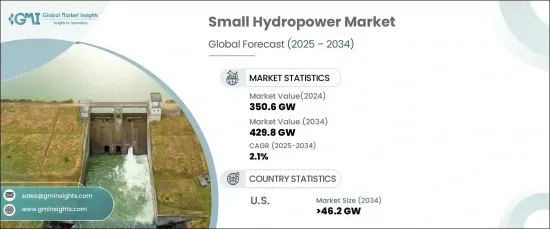
|
시장보고서
상품코드
1666565
소수력 발전 시장 : 기회, 성장 촉진요인, 산업 동향 분석 및 예측(2025-2034년)Small Hydropower Market Opportunity, Growth Drivers, Industry Trend Analysis, and Forecast 2025 - 2034 |
||||||
세계의 소수력 발전 시장은 2024년까지 350.6GW의 용량을 달성했으며, 2025년부터 2034년까지 2025년부터 2034년까지 2.1%의 연평균 성장률을 보일 것으로 전망됩니다.
이러한 성장은 주로 재생 에너지에 대한 수요 증가, 지속 가능성에 대한 관심 증가, 기술 발전에 의해 주도되고 있습니다.

소수력 발전은 100kW에서 10MW 사이의 용량을 가진 수력 발전 시스템을 말하며, 외딴 지역, 소규모 유틸리티 및 지역 사회에서 접근 가능한 옵션입니다. 이러한 시스템은 확장성과 다용도로 인해 분산형 에너지 솔루션으로의 글로벌 전환에 핵심적인 기여를 하고 있습니다. 이러한 시스템은 오프그리드 및 마이크로그리드 설정을 지원하여 안정적인 그리드 액세스가 부족한 지역의 요구를 해결합니다. 특히 터빈 효율과 비용 등 기술적인 개선은 전 세계적으로 소수력 발전 시스템의 도입 가능성을 더욱 높이고 있습니다.
미국의 소수력 발전 시장은 온실가스 배출을 줄이고 더 많은 재생 에너지원을 통합하려는 연방 정부의 노력에 힘입어 2034년까지 46.2GW를 넘어설 것으로 예상됩니다. 인센티브, 세금 혜택, 보조금과 같은 우호적인 정책도 재생 에너지의 광범위한 채택을 장려하고 있습니다. 이 청정 에너지원은 보다 지속 가능한 에너지 믹스로 전환하려는 목표에 부합하는 실용적이고 신뢰할 수 있는 솔루션을 제공합니다.
아시아태평양 지역에서 소수력 발전은 외딴 지역의 에너지 문제를 해결하기 위한 필수적인 도구로 떠오르고 있습니다. 이러한 시스템은 지역 수자원을 활용하여 안정적인 전력을 공급함으로써 화석 연료에 대한 의존도를 최소화하고 에너지 안보를 개선합니다. 소수력 발전 프로젝트는 국가 전력망과 독립적으로 운영할 수 있기 때문에 고립된 지역사회에 특히 유용합니다. 소수력 발전은 자급자족을 촉진하고 환경에 미치는 영향을 줄임으로써 농촌 지역에 전력을 공급하는 효과적인 솔루션으로 계속 주목받고 있습니다.
목차
제1장 조사 방법과 조사 범위
- 시장의 정의
- 기본 추정과 계산
- 예측 계산
- 데이터 출처
- 1차
- 2차
- 유상
- 공개
제2장 주요 요약
제3장 업계 인사이트
- 업계 생태계 분석
- 규제 상황
- 업계에 미치는 영향요인
- 성장 촉진요인
- 업계의 잠재적 위험 및 과제
- 성장 가능성 분석
- Porter's Five Forces 분석
- 공급기업의 협상력
- 구매자의 협상력
- 신규 진입업자의 위협
- 대체품의 위협
- PESTEL 분석
제4장 경쟁 구도
- 전략 대시보드
- 혁신과 지속가능성의 전망
제5장 시장 규모와 예측 : 지역별(2021-2034년)
- 주요 동향
- 북미
- 미국
- 캐나다
- 멕시코
- 유럽
- 영국
- 독일
- 프랑스
- 스페인
- 이탈리아
- 러시아
- 터키
- 노르웨이
- 아시아태평양
- 중국
- 일본
- 인도
- 호주
- 세계 기타 지역
- 브라질
- 이란
제6장 기업 프로파일
- 24H - Hydro Power
- Agder Energi
- Andritz Hydro
- Derwent Hydroelectric Power
- Fortum
- General Electric
- Lanco Group
- RusHydro
- Siemens
- Statkraft
- Voith
The Global Small Hydropower Market is projected to achieve a capacity of 350.6 GW by 2024 and is expected to grow at a CAGR of 2.1% between 2025 and 2034. This growth is largely driven by rising demand for renewable energy, increased focus on sustainability, and advancements in technology.

Small hydropower refers to hydroelectric systems with a capacity between 100 kW and 10 MW, making them an accessible option for remote areas, small utilities, and local communities. Their scalability and versatility make these systems a key contributor to the global transition towards decentralized energy solutions. These systems support off-grid and microgrid setups, addressing the needs of regions lacking reliable grid access. Technological improvements, particularly in turbine efficiency and cost, further enhance the feasibility of adopting small hydropower systems globally.
In the United States, the small hydropower market is expected to surpass 46.2 GW by 2034, fueled by federal initiatives aimed at reducing greenhouse gas emissions and integrating more renewable energy sources. Favorable policies, such as incentives, tax benefits, and grants, are also encouraging widespread adoption. This cleaner energy source offers a practical and reliable solution, aligning with goals to transition to a more sustainable energy mix.
In the Asia Pacific, small hydropower is emerging as an essential tool to address energy challenges in remote and underserved regions. These systems leverage local water resources to deliver reliable power, minimizing reliance on fossil fuels while improving energy security. The ability of small hydropower projects to operate independently of national grids makes them particularly beneficial for isolated communities. By promoting self-sufficiency and reducing environmental impact, small hydropower continues to gain traction as an effective solution for powering rural areas.
Table of Contents
Chapter 1 Methodology & Scope
- 1.1 Market definitions
- 1.2 Base estimates & calculations
- 1.3 Forecast calculation
- 1.4 Data sources
- 1.4.1 Primary
- 1.4.2 Secondary
- 1.4.2.1 Paid
- 1.4.2.2 Public
Chapter 2 Executive Summary
- 2.1 Industry synopsis, 2021 – 2034
Chapter 3 Industry Insights
- 3.1 Industry ecosystem analysis
- 3.2 Regulatory landscape
- 3.3 Industry impact forces
- 3.3.1 Growth drivers
- 3.3.2 Industry pitfalls & challenges
- 3.4 Growth potential analysis
- 3.5 Porter's Analysis
- 3.5.1 Bargaining power of suppliers
- 3.5.2 Bargaining power of buyers
- 3.5.3 Threat of new entrants
- 3.5.4 Threat of substitutes
- 3.6 PESTEL Analysis
Chapter 4 Competitive landscape, 2024
- 4.1 Strategic dashboard
- 4.2 Innovation & sustainability landscape
Chapter 5 Market Size and Forecast, By Region, 2021 – 2034 (GW)
- 5.1 Key trends
- 5.2 North America
- 5.2.1 U.S.
- 5.2.2 Canada
- 5.2.3 Mexico
- 5.3 Europe
- 5.3.1 UK
- 5.3.2 Germany
- 5.3.3 France
- 5.3.4 Spain
- 5.3.5 Italy
- 5.3.6 Russia
- 5.3.7 Turkey
- 5.3.8 Norway
- 5.4 Asia Pacific
- 5.4.1 China
- 5.4.2 Japan
- 5.4.3 India
- 5.4.4 Australia
- 5.5 Rest of World
- 5.5.1 Brazil
- 5.5.2 Iran
Chapter 6 Company Profiles
- 6.1 24H - Hydro Power
- 6.2 Agder Energi
- 6.3 Andritz Hydro
- 6.4 Derwent Hydroelectric Power
- 6.5 Fortum
- 6.6 General Electric
- 6.7 Lanco Group
- 6.8 RusHydro
- 6.9 Siemens
- 6.10 Statkraft
- 6.11 Voith



















